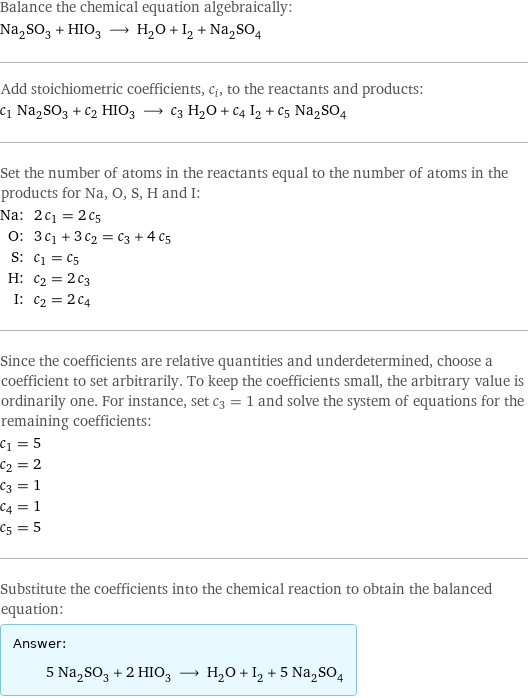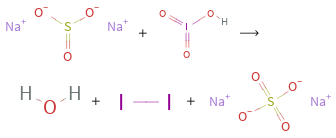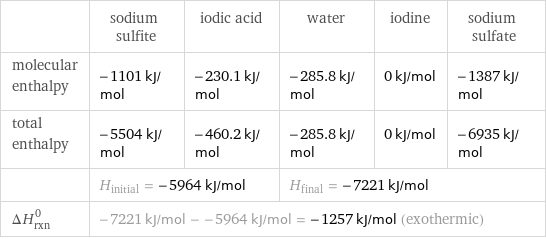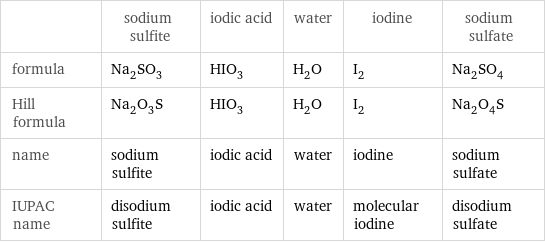Input interpretation

Na_2SO_3 sodium sulfite + HIO_3 iodic acid ⟶ H_2O water + I_2 iodine + Na_2SO_4 sodium sulfate
Balanced equation

Balance the chemical equation algebraically: Na_2SO_3 + HIO_3 ⟶ H_2O + I_2 + Na_2SO_4 Add stoichiometric coefficients, c_i, to the reactants and products: c_1 Na_2SO_3 + c_2 HIO_3 ⟶ c_3 H_2O + c_4 I_2 + c_5 Na_2SO_4 Set the number of atoms in the reactants equal to the number of atoms in the products for Na, O, S, H and I: Na: | 2 c_1 = 2 c_5 O: | 3 c_1 + 3 c_2 = c_3 + 4 c_5 S: | c_1 = c_5 H: | c_2 = 2 c_3 I: | c_2 = 2 c_4 Since the coefficients are relative quantities and underdetermined, choose a coefficient to set arbitrarily. To keep the coefficients small, the arbitrary value is ordinarily one. For instance, set c_3 = 1 and solve the system of equations for the remaining coefficients: c_1 = 5 c_2 = 2 c_3 = 1 c_4 = 1 c_5 = 5 Substitute the coefficients into the chemical reaction to obtain the balanced equation: Answer: | | 5 Na_2SO_3 + 2 HIO_3 ⟶ H_2O + I_2 + 5 Na_2SO_4
Structures

+ ⟶ + +
Names

sodium sulfite + iodic acid ⟶ water + iodine + sodium sulfate
Reaction thermodynamics
Enthalpy

| sodium sulfite | iodic acid | water | iodine | sodium sulfate molecular enthalpy | -1101 kJ/mol | -230.1 kJ/mol | -285.8 kJ/mol | 0 kJ/mol | -1387 kJ/mol total enthalpy | -5504 kJ/mol | -460.2 kJ/mol | -285.8 kJ/mol | 0 kJ/mol | -6935 kJ/mol | H_initial = -5964 kJ/mol | | H_final = -7221 kJ/mol | | ΔH_rxn^0 | -7221 kJ/mol - -5964 kJ/mol = -1257 kJ/mol (exothermic) | | | |
Equilibrium constant
![Construct the equilibrium constant, K, expression for: Na_2SO_3 + HIO_3 ⟶ H_2O + I_2 + Na_2SO_4 Plan: • Balance the chemical equation. • Determine the stoichiometric numbers. • Assemble the activity expression for each chemical species. • Use the activity expressions to build the equilibrium constant expression. Write the balanced chemical equation: 5 Na_2SO_3 + 2 HIO_3 ⟶ H_2O + I_2 + 5 Na_2SO_4 Assign stoichiometric numbers, ν_i, using the stoichiometric coefficients, c_i, from the balanced chemical equation in the following manner: ν_i = -c_i for reactants and ν_i = c_i for products: chemical species | c_i | ν_i Na_2SO_3 | 5 | -5 HIO_3 | 2 | -2 H_2O | 1 | 1 I_2 | 1 | 1 Na_2SO_4 | 5 | 5 Assemble the activity expressions accounting for the state of matter and ν_i: chemical species | c_i | ν_i | activity expression Na_2SO_3 | 5 | -5 | ([Na2SO3])^(-5) HIO_3 | 2 | -2 | ([HIO3])^(-2) H_2O | 1 | 1 | [H2O] I_2 | 1 | 1 | [I2] Na_2SO_4 | 5 | 5 | ([Na2SO4])^5 The equilibrium constant symbol in the concentration basis is: K_c Mulitply the activity expressions to arrive at the K_c expression: Answer: | | K_c = ([Na2SO3])^(-5) ([HIO3])^(-2) [H2O] [I2] ([Na2SO4])^5 = ([H2O] [I2] ([Na2SO4])^5)/(([Na2SO3])^5 ([HIO3])^2)](../image_source/e6fa809f9f8c7cdc3fb9280bfacf275d.png)
Construct the equilibrium constant, K, expression for: Na_2SO_3 + HIO_3 ⟶ H_2O + I_2 + Na_2SO_4 Plan: • Balance the chemical equation. • Determine the stoichiometric numbers. • Assemble the activity expression for each chemical species. • Use the activity expressions to build the equilibrium constant expression. Write the balanced chemical equation: 5 Na_2SO_3 + 2 HIO_3 ⟶ H_2O + I_2 + 5 Na_2SO_4 Assign stoichiometric numbers, ν_i, using the stoichiometric coefficients, c_i, from the balanced chemical equation in the following manner: ν_i = -c_i for reactants and ν_i = c_i for products: chemical species | c_i | ν_i Na_2SO_3 | 5 | -5 HIO_3 | 2 | -2 H_2O | 1 | 1 I_2 | 1 | 1 Na_2SO_4 | 5 | 5 Assemble the activity expressions accounting for the state of matter and ν_i: chemical species | c_i | ν_i | activity expression Na_2SO_3 | 5 | -5 | ([Na2SO3])^(-5) HIO_3 | 2 | -2 | ([HIO3])^(-2) H_2O | 1 | 1 | [H2O] I_2 | 1 | 1 | [I2] Na_2SO_4 | 5 | 5 | ([Na2SO4])^5 The equilibrium constant symbol in the concentration basis is: K_c Mulitply the activity expressions to arrive at the K_c expression: Answer: | | K_c = ([Na2SO3])^(-5) ([HIO3])^(-2) [H2O] [I2] ([Na2SO4])^5 = ([H2O] [I2] ([Na2SO4])^5)/(([Na2SO3])^5 ([HIO3])^2)
Rate of reaction
![Construct the rate of reaction expression for: Na_2SO_3 + HIO_3 ⟶ H_2O + I_2 + Na_2SO_4 Plan: • Balance the chemical equation. • Determine the stoichiometric numbers. • Assemble the rate term for each chemical species. • Write the rate of reaction expression. Write the balanced chemical equation: 5 Na_2SO_3 + 2 HIO_3 ⟶ H_2O + I_2 + 5 Na_2SO_4 Assign stoichiometric numbers, ν_i, using the stoichiometric coefficients, c_i, from the balanced chemical equation in the following manner: ν_i = -c_i for reactants and ν_i = c_i for products: chemical species | c_i | ν_i Na_2SO_3 | 5 | -5 HIO_3 | 2 | -2 H_2O | 1 | 1 I_2 | 1 | 1 Na_2SO_4 | 5 | 5 The rate term for each chemical species, B_i, is 1/ν_i(Δ[B_i])/(Δt) where [B_i] is the amount concentration and t is time: chemical species | c_i | ν_i | rate term Na_2SO_3 | 5 | -5 | -1/5 (Δ[Na2SO3])/(Δt) HIO_3 | 2 | -2 | -1/2 (Δ[HIO3])/(Δt) H_2O | 1 | 1 | (Δ[H2O])/(Δt) I_2 | 1 | 1 | (Δ[I2])/(Δt) Na_2SO_4 | 5 | 5 | 1/5 (Δ[Na2SO4])/(Δt) (for infinitesimal rate of change, replace Δ with d) Set the rate terms equal to each other to arrive at the rate expression: Answer: | | rate = -1/5 (Δ[Na2SO3])/(Δt) = -1/2 (Δ[HIO3])/(Δt) = (Δ[H2O])/(Δt) = (Δ[I2])/(Δt) = 1/5 (Δ[Na2SO4])/(Δt) (assuming constant volume and no accumulation of intermediates or side products)](../image_source/982b60482d86149b28718d99b990af54.png)
Construct the rate of reaction expression for: Na_2SO_3 + HIO_3 ⟶ H_2O + I_2 + Na_2SO_4 Plan: • Balance the chemical equation. • Determine the stoichiometric numbers. • Assemble the rate term for each chemical species. • Write the rate of reaction expression. Write the balanced chemical equation: 5 Na_2SO_3 + 2 HIO_3 ⟶ H_2O + I_2 + 5 Na_2SO_4 Assign stoichiometric numbers, ν_i, using the stoichiometric coefficients, c_i, from the balanced chemical equation in the following manner: ν_i = -c_i for reactants and ν_i = c_i for products: chemical species | c_i | ν_i Na_2SO_3 | 5 | -5 HIO_3 | 2 | -2 H_2O | 1 | 1 I_2 | 1 | 1 Na_2SO_4 | 5 | 5 The rate term for each chemical species, B_i, is 1/ν_i(Δ[B_i])/(Δt) where [B_i] is the amount concentration and t is time: chemical species | c_i | ν_i | rate term Na_2SO_3 | 5 | -5 | -1/5 (Δ[Na2SO3])/(Δt) HIO_3 | 2 | -2 | -1/2 (Δ[HIO3])/(Δt) H_2O | 1 | 1 | (Δ[H2O])/(Δt) I_2 | 1 | 1 | (Δ[I2])/(Δt) Na_2SO_4 | 5 | 5 | 1/5 (Δ[Na2SO4])/(Δt) (for infinitesimal rate of change, replace Δ with d) Set the rate terms equal to each other to arrive at the rate expression: Answer: | | rate = -1/5 (Δ[Na2SO3])/(Δt) = -1/2 (Δ[HIO3])/(Δt) = (Δ[H2O])/(Δt) = (Δ[I2])/(Δt) = 1/5 (Δ[Na2SO4])/(Δt) (assuming constant volume and no accumulation of intermediates or side products)
Chemical names and formulas

| sodium sulfite | iodic acid | water | iodine | sodium sulfate formula | Na_2SO_3 | HIO_3 | H_2O | I_2 | Na_2SO_4 Hill formula | Na_2O_3S | HIO_3 | H_2O | I_2 | Na_2O_4S name | sodium sulfite | iodic acid | water | iodine | sodium sulfate IUPAC name | disodium sulfite | iodic acid | water | molecular iodine | disodium sulfate
Substance properties

| sodium sulfite | iodic acid | water | iodine | sodium sulfate molar mass | 126.04 g/mol | 175.91 g/mol | 18.015 g/mol | 253.80894 g/mol | 142.04 g/mol phase | solid (at STP) | solid (at STP) | liquid (at STP) | solid (at STP) | solid (at STP) melting point | 500 °C | 110 °C | 0 °C | 113 °C | 884 °C boiling point | | | 99.9839 °C | 184 °C | 1429 °C density | 2.63 g/cm^3 | 4.629 g/cm^3 | 1 g/cm^3 | 4.94 g/cm^3 | 2.68 g/cm^3 solubility in water | | very soluble | | | soluble surface tension | | | 0.0728 N/m | | dynamic viscosity | | | 8.9×10^-4 Pa s (at 25 °C) | 0.00227 Pa s (at 116 °C) | odor | | | odorless | |
Units
